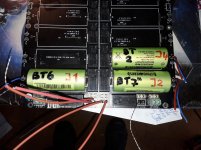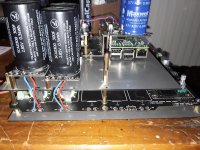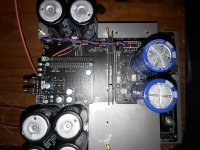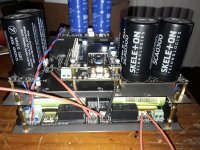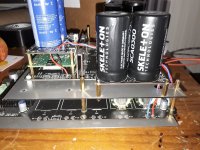Hello Ian,
As you can see i already removed one cell but i can reinstall it again.
The blue/red kimber will be attached to the 3 UcHybrid boards.
J1 will go to the terminal J5 on the Stationpi board to supply 3,3 volt to the side of the fifopi which is normally supplied with 5 volt.
J2 will go to the 3,3 volt terminal on the fifopi.
J3 will go to the reclockpi circuit.
J4 is not used but can be used when cell 4 is reinstalled again.
J1, J2 and J3 all have an UcHybrid board so i guess J4 can be put in parallel with one of them.
BIG question which will give an improvement? Go for the cell that is facing the biggest " current drain"? Maybe an advantage if you can make the time without charging a bit longer?
In the end i could end up with ucpure but for months to come i will go for this solution.
WHERE can i found more info on how to connect the several earth connections.
Lifepo4 board is mounted with metal stand off to the metal chassis.
Greetings,Eduard
As you can see i already removed one cell but i can reinstall it again.
The blue/red kimber will be attached to the 3 UcHybrid boards.
J1 will go to the terminal J5 on the Stationpi board to supply 3,3 volt to the side of the fifopi which is normally supplied with 5 volt.
J2 will go to the 3,3 volt terminal on the fifopi.
J3 will go to the reclockpi circuit.
J4 is not used but can be used when cell 4 is reinstalled again.
J1, J2 and J3 all have an UcHybrid board so i guess J4 can be put in parallel with one of them.
BIG question which will give an improvement? Go for the cell that is facing the biggest " current drain"? Maybe an advantage if you can make the time without charging a bit longer?
In the end i could end up with ucpure but for months to come i will go for this solution.
WHERE can i found more info on how to connect the several earth connections.
Lifepo4 board is mounted with metal stand off to the metal chassis.
Greetings,Eduard
Attachments
Hi Ian,
I received SinePi the other day (thank you very much) and I am trying to integrate it. I have a strange issue that I am working through and I have a few questions:
Can you tell me whether I am able to use the SinePi with just one external sine wave connected to either SMA socket (without a local XO)? It says that this should be fine in the manual but all the images I have seen either have 2 sma connections or 1 sma connection and a local XO connected to the SinePI. I’m just checking that this isn’t my issue…as I have only an external sine wave clock connected to the SMA for initial testing.
If that’s not the problem then my setup is as follows:
Fifopi > McFifo > dual mono buffalo IIISE’s running in sync mode
The fifopi uses 45/49 clocks for the purposes of this test.
With the sinepi connected to the McFIFO with one external clock connected running at either 22 or 24Mhz (to either SMA socket - I’ve tried both) I get no lit lock LED on the master DAC board but music does play at about one third of the volume!
Replacing the SinePI with local 22/24 XOs in the McFifo I can play music perfectly well to 192k (and the volume/clarity is ‘correct’).
Any ideas?
Many thanks, Crom
I received SinePi the other day (thank you very much) and I am trying to integrate it. I have a strange issue that I am working through and I have a few questions:
Can you tell me whether I am able to use the SinePi with just one external sine wave connected to either SMA socket (without a local XO)? It says that this should be fine in the manual but all the images I have seen either have 2 sma connections or 1 sma connection and a local XO connected to the SinePI. I’m just checking that this isn’t my issue…as I have only an external sine wave clock connected to the SMA for initial testing.
If that’s not the problem then my setup is as follows:
Fifopi > McFifo > dual mono buffalo IIISE’s running in sync mode
The fifopi uses 45/49 clocks for the purposes of this test.
With the sinepi connected to the McFIFO with one external clock connected running at either 22 or 24Mhz (to either SMA socket - I’ve tried both) I get no lit lock LED on the master DAC board but music does play at about one third of the volume!
Replacing the SinePI with local 22/24 XOs in the McFifo I can play music perfectly well to 192k (and the volume/clarity is ‘correct’).
Any ideas?
Many thanks, Crom
@Crom
McDualXO clock board has 1K resistors to the OE pins of XO sockets. So, it may not have enough current to drive the relay on SinePi.
You can try to short the 1K R28 on McDualXO, then you will hear the click sound of the relay when switching. Or short both R28 and R31.
Please let me know if you have new update.
Regards,
Ian
McDualXO clock board has 1K resistors to the OE pins of XO sockets. So, it may not have enough current to drive the relay on SinePi.
You can try to short the 1K R28 on McDualXO, then you will hear the click sound of the relay when switching. Or short both R28 and R31.
Please let me know if you have new update.
Regards,
Ian
Last edited:
Hello,
GOOGLE told me 80/100 mA for the 5 volt side of fifopi and 33/44 mA for the other side.
Reclockpi is also well below 100 mA if i remember well.
Have to read entire threads to find out.
Earthing the same problem.
What a pity.
Greetings, eduard
GOOGLE told me 80/100 mA for the 5 volt side of fifopi and 33/44 mA for the other side.
Reclockpi is also well below 100 mA if i remember well.
Have to read entire threads to find out.
Earthing the same problem.
What a pity.
Greetings, eduard
Hello,
I managed to put one extra lifepo4 cell in parallel to the one feeding the Reclockpi circuit. J4 terminal was the terminal with no UcHybrid circuit connected in parallel so the closest one was J3 which is feeding the Reclockpi.
As you can see it was not that difficult to '' improve '' the connection between UcHybrid and the lifepo4 board.
The complete 'construction '' pictured in the attachment will be mounted in my DDDAC chassis in such a way that the stainless steel '' mounting plate '' is connected to the DDDAC chassis.
ALL the boards ( 3 UcHybrids, liofepo4 board, Raspberry, Reclockpi, Sinepi, Stationpi and Fifopi are mounted using metal stand offs. The 5 volt supply on the lifepo4 board is used for feeding the Raspberry. The input voltage for the lifepo4 comes from a well designed ( Doede) supply.
In one of the attachment you can see a screenshot ( made long time ago)that has some information telling me in my situation the lifepo4 should be mounted on isolating stand offs.
What about the other stand offs in my construction?
As you can see there is an additional stainless steel mounting plate mounted with the 4 holes at 186/104 mm hole ''pattern '' located at the ''terminal side '' of the lifepo4 board. So things are well connected.
There are several earth soldering '' spots '' on the Stationpi. Which one(s) to use and where to connect exactly?
FIRST have to get this construction working before switching to Ucpure. If things are not used according to certain '' standards '' moving to Ucpure is pretty useless i think.
Thanks in advance and greetings, Eduard
P.s Also asked Ian by mail but better if correct info is shared here. Like i wrote before non native English speakers who are also dont have education in this subject need CLEAR info otherwise they will look somewhere else or just get stuff from China that needs a smaller investment
I managed to put one extra lifepo4 cell in parallel to the one feeding the Reclockpi circuit. J4 terminal was the terminal with no UcHybrid circuit connected in parallel so the closest one was J3 which is feeding the Reclockpi.
As you can see it was not that difficult to '' improve '' the connection between UcHybrid and the lifepo4 board.
The complete 'construction '' pictured in the attachment will be mounted in my DDDAC chassis in such a way that the stainless steel '' mounting plate '' is connected to the DDDAC chassis.
ALL the boards ( 3 UcHybrids, liofepo4 board, Raspberry, Reclockpi, Sinepi, Stationpi and Fifopi are mounted using metal stand offs. The 5 volt supply on the lifepo4 board is used for feeding the Raspberry. The input voltage for the lifepo4 comes from a well designed ( Doede) supply.
In one of the attachment you can see a screenshot ( made long time ago)that has some information telling me in my situation the lifepo4 should be mounted on isolating stand offs.
What about the other stand offs in my construction?
As you can see there is an additional stainless steel mounting plate mounted with the 4 holes at 186/104 mm hole ''pattern '' located at the ''terminal side '' of the lifepo4 board. So things are well connected.
There are several earth soldering '' spots '' on the Stationpi. Which one(s) to use and where to connect exactly?
FIRST have to get this construction working before switching to Ucpure. If things are not used according to certain '' standards '' moving to Ucpure is pretty useless i think.
Thanks in advance and greetings, Eduard
P.s Also asked Ian by mail but better if correct info is shared here. Like i wrote before non native English speakers who are also dont have education in this subject need CLEAR info otherwise they will look somewhere else or just get stuff from China that needs a smaller investment
Attachments
Hi Ian,Ian,
I am interested in a McReClock version
Are you planning a McFIFO version of the ReclockPi?
nounouchet
raspberry pi does not have multichannel i2s, there is no means to get multichannel i2s out of an rpi, other than first outputting to a USB->multichannel i2s interface, so there is no possibility for a MC-reclock pi.Hi Ian,
Are you planning a McFIFO version of the ReclockPi?
nounouchet
Last night my friend brought to my home his brand new Chord Hugo TT and M-Scaler which costs approx £8,000.
We first listen to my Signature DDDAC which is supported by Ian Canada solutions, Andrea clocks and high quality PSUs. My friend stated this was the best sound he has ever heard and he stated he felt the Chord should be better as a major brand 😊
So we quickly swapped the Chord in replacing my DDDAC and everything else was the same and same music all via Roon.
We listened to a few tracks and he stated nothing for sometime. he then stated to me that he was shocked that with the Chord the sound was not as good and was a very noticeable difference. 😀
We switched back to the DDDAC solution and both of us agreed MUCH MUCH better sound! Its amazing what this DIY community can design and deliver to us all
A HUGE thank you to Doede, Ian and Andrea for there amazing dedication, skill and effort they give for all our benefits!

 😀
😀
We first listen to my Signature DDDAC which is supported by Ian Canada solutions, Andrea clocks and high quality PSUs. My friend stated this was the best sound he has ever heard and he stated he felt the Chord should be better as a major brand 😊
So we quickly swapped the Chord in replacing my DDDAC and everything else was the same and same music all via Roon.
We listened to a few tracks and he stated nothing for sometime. he then stated to me that he was shocked that with the Chord the sound was not as good and was a very noticeable difference. 😀
We switched back to the DDDAC solution and both of us agreed MUCH MUCH better sound! Its amazing what this DIY community can design and deliver to us all
A HUGE thank you to Doede, Ian and Andrea for there amazing dedication, skill and effort they give for all our benefits!


 😀
😀Don't forget to give the Chord some burn-in time. You may or may not still rate it the same after letting it run for a couple of weeks. Also, many people report improved sound from from Hugo TT 2, if using a linear power supply rather than the included SMPS. (IIUC, Hugo TT 2 is a newer model than Hugo TT.)
EDIT: May I ask what was the other equipment used in the reproduction system besides the DACs?
EDIT: May I ask what was the other equipment used in the reproduction system besides the DACs?
Last edited:
Hello,
Doede had other goals when he started with his products. If you buy a product that has a case that requires a high tech 3D milling machine to make it you have to know that a big part of the price you pay is on the outside while the money ( parts but mainly labour) should be inside.
If you want good reliable parts you will need to do some investment.
Even here where there should be some serious hobbyists people still looking for bargain prices ultracaps.
Go for cheaper caps but then bypass the fuse to get that little extra sound quality. Leave it on 24/7 with no fuse and sub standard caps i wouldnt do that but i experienced multiple fires ( house and hotel) all covered by insurance and the ones in the house all coming from outside.
Greetings, eduard
Doede had other goals when he started with his products. If you buy a product that has a case that requires a high tech 3D milling machine to make it you have to know that a big part of the price you pay is on the outside while the money ( parts but mainly labour) should be inside.
If you want good reliable parts you will need to do some investment.
Even here where there should be some serious hobbyists people still looking for bargain prices ultracaps.
Go for cheaper caps but then bypass the fuse to get that little extra sound quality. Leave it on 24/7 with no fuse and sub standard caps i wouldnt do that but i experienced multiple fires ( house and hotel) all covered by insurance and the ones in the house all coming from outside.
Greetings, eduard
How quick is quickly (seconds or minutes) and what did you use for making the listening position the same?So we quickly swapped the Chord in replacing my DDDAC and everything else was the same
Minutes, everything in the system was the same except the dac
come over and listen yourself as was plain as day 😉
come over and listen yourself as was plain as day 😉
Minutes are too long for human aural memory span to be effective. What did you use for making the listening position and the levels same? If you get those taken care, then maybe I can contemplate on coming over.Minutes, everything in the system was the same except the dac
I highly doubt anyone needs you to design a proper controlled listening test for them. I'd also bet many of us would be amused at your likely suggestion of ultra rapid ABX as clearly and demonstrably superior, and probably even more so your method for determining and ensuring an ultra specific listening position, otherwise all impressions are completely invalid.Minutes are too long for human aural memory span to be effective. What did you use for making the listening position and the levels same? If you get those taken care, then maybe I can contemplate on coming over.
Besides doubting and betting, you can also try it yourself. For starter, while listening to your favorites, turn your head a few degrees and back or move couple of inches and back. See what happens when you do.
We know what we heard, same listening position the lot. It’s not a debate as far as we are concerned, moving on……. 👍
Thanks @iancanada, I needed to short both R28 and R31 before the relay was driven correctly. I can now hear the relay click.@Crom
McDualXO clock board has 1K resistors to the OE pins of XO sockets. So, it may not have enough current to drive the relay on SinePi.
You can try to short the 1K R28 on McDualXO, then you will hear the click sound of the relay when switching. Or short both R28 and R31.
Please let me know if you have new update.
Regards,
Ian
I also get the correct DAC lock LED lit.
However, when playing music the McDualXO board constantly changes between XO. This now correctly switches the relay...causing plenty of clicks... but no music.
Can you confirm that I am OK to replace the SinePi with XOs now that the resistors have been shorted. I can't think of a reason why not but wanted to check before continuing to test.
Thanks,
Crom
I'm not doubting that you've perceived something. The debate is about what caused it. For digital audio components these days, it's typically the listening level mismatch between devices compared that caused it. Other common causes are expectation, power of suggestion and personal mood at the time.We know what we heard, same listening position the lot. It’s not a debate as far as we are concerned, moving on……. 👍
- Home
- Source & Line
- Digital Line Level
- Asynchronous I2S FIFO project, an ultimate weapon to fight the jitter
